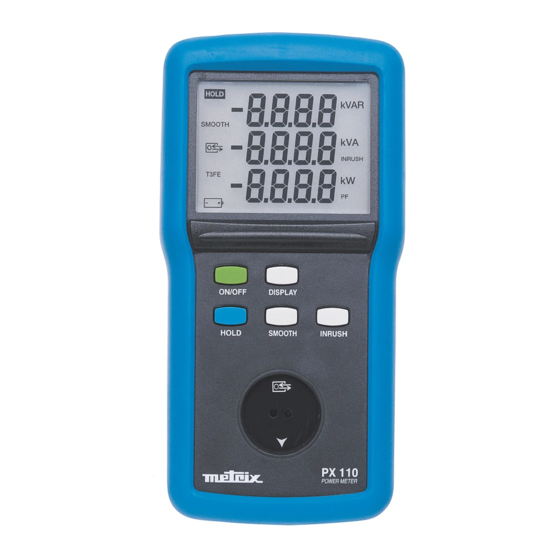
Table of Contents
Advertisement
Advertisement
Table of Contents

Summary of Contents for Metrix PX 110
- Page 1 PX 110 - PX 120 北京海洋兴业科技股份有限公司(证券代码:839145) 电话:010-62176775...
- Page 2 Ž Ž Ž Ž Ž ON/OFF DISPLAY HOLD SMOOTH INRUSH PX 110 POWER METER Se reporter au § 2. Description See § 2. Description Siehe § 2. Beschreibung Vedi § 2. Descrizione Remitirse al § 2. Descripción Puissancemètres...
- Page 3 Œ Œ Œ Œ Œ HOLD kVAR SMOOTH INRUSH T3FE Ž Ž Ž Ž Ž ON/OFF DISPLAY T3FE HOLD SMOOTH INRUSH PX 120 POWER METER Se reporter au § 2. Description See §...
-
Page 4: Table Of Contents
4.4 Compliance with norms ....................33 4.5 Variations in operating range ..................34 5. ACCESSORIES ........................34 5.1 Delivered with the wattmeters PX 110 / PX 120 ............. 34 5.2 Delivered as options ......................34 6. MAINTENANCE ........................35 6.1 Replacing the batteries ....................35 6.2 Replacing the fuse ...................... -
Page 5: General Instructions
Chapter I GENERAL INSTRUCTIONS Thank you for purchasing this PX 110 or PX 120 wattmeter. This instrument complies with the NF EN 61010 safety standard concerning electronic measurement instruments. For your own safety and to prevent damage to the instrument, it is essential to respect the instructions given in this manual. -
Page 6: Protective Systems
Chapter I 1.1.3 Symbols The following symbols are used: ATTENTION: Consult the manual. Incorrect use may damage the instrument and endanger the user. This appliance is protected by dual insulation or reinforced insulation. It does not have to be connected to an earth protection terminal for electrical safety. 1.1.4 Instructions * Before opening the instrument, disconnect if from all sources of electrical current and... -
Page 7: Repair And Metrological Verification
DESCRIPTION OF THE INSTRUMENT The PX 110 and PX 120 wattmeters can be used to measure AC and DC power levels, voltages and currents. They have been designed specifically for general and technical colleges, installers and maintenance departments. -
Page 8: Casing (See The Diagrams At The Beginning Of This Operating Manual)
Safety sockets for input of the voltages to be measured Ž Ž Ž Ž Ž Control keys (5 for the PX 110 and 6 for the PX120) ON / OFF Activation / shutdown DISPLAY Gives access to the various screens by successive presses... -
Page 9: Inrush Function
Chapter III 2.2.2 Display of the function symbols HOLD Indicates use of the corresponding key (see § 2.1) SMOOTH Indicates use of the corresponding key (see § 2.1) Indicates that communication is activated (see § 3.6) T3FE Indicates use of the corresponding key for three-phase/balanced wires measurement (only on PX 120) Indicates that the remaining battery charge life is <... -
Page 10: Voltage Measurements (V)
Chapter III Voltage measurements 1. Press the ON/OFF key: the first screen appears 2. Connect the measurement leads to the instrument’s voltage measurement terminals (on the right), complying with the polarities indicated: red lead on the “+” terminal and black lead on the “COM”... -
Page 11: Power Measurements
Chapter III 3.3.1 Specific reference conditions DC: AC component 0.1% of the DC signal AC: Sinusoidal signal (THD < 0.1%) 3.3.2 Characteristics in normal and SMOOTH modes Display range 10 A (1) Measuring range 10 mA...1.999 A 2.00...9.99 A Accuracy for AC 0.7% of reading ±5 cts +1 mA 0.7% of reading ±5 cts Accuracy for DC... - Page 12 Chapter III Charge Alimentation Load Power supply Fig 4.4.2 Three-phase/balanced wires (T3FE) connection diagram (PX 120 only) I I I I I Common characteristics of power measurements The active and reactive power measurements are signed, whereas the apparent power measurement is not. The display indicates “OL”...
- Page 13 Chapter III 3.4.3 Apparent power measurements 1. Press the ON/OFF key: the first screen appears 2. Connect the measurement leads to the instrument’s current measurement terminals (on the left), complying with the polarities indicated: red lead on the “+” terminal and black lead on the “COM”...
- Page 14 Chapter III I I I I I Single-phase characteristics Display range 1000 VA 6 kVA Measuring range 10.0 VA...999.9 VA 1000 VA...5999 kVA Accuracy at 50 Hz for cos ϕ =0.6 2%% of reading ±2 cts 2% of reading ±2 cts Resolution 0.1 VA 1 VA...
-
Page 15: Communication (Option)
Connection I I I I I The adapter hatch is fitted and then locked on the PX 110/120, with the measurement lead disconnected. The plug of the unit is connected to a “Europe”-type wall mains socket with the lead underneath. -
Page 16: Environmental Parameters
Chapter IV Environmental parameters Climatic conditions I I I I I Ž Œ Ž Œ Reference range Operating range Ž Storage range (without battery) 20 26 Temperature in °C Note: The operating range (2) is reduced to 40°C with the mains adapter accessory. Altitude I I I I I - Operation: ≤... -
Page 17: Variations In Operating Range
U = 230V 50 Hz Note: The term Power covers the active power P and its associated values Q, S and PF. ACCESSORIES Delivered with the wattmeters PX 110 / PX 120 2 sets of safety leads 1 set of leads with touch prods Six 1.5 V batteries... -
Page 18: Maintenance
Chapter VI MAINTENANCE Only use specified spare parts for maintenance purposes. The manufacturer cannot accept any responsibility for accidents occurring following repairs carried out outside its after-sales department or approved maintenance network. Replacing the batteries Disconnect the leads from the instrument I Press the OFF key I Unscrew the “quarter-turn screw”...













Need help?
Do you have a question about the PX 110 and is the answer not in the manual?
Questions and answers